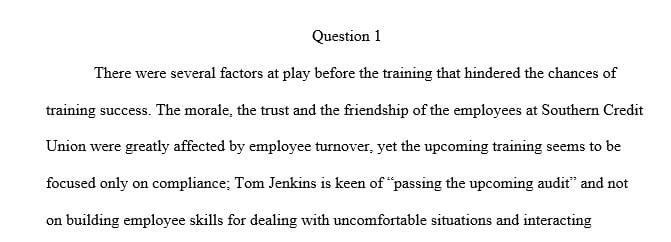How was transfer supported or not supported in this organization before training
Read the following mini case and answer the questions that follow:
Southern Credit Union operates in more than 10 medium-sized cities in a southeastern state. As a credit union, Southern is owned by their members who save and borrow money through the institution. A portion of the union’s profits is returned to members in various ways, including lower interest rates, lower fees and higher dividends on savings accounts. Southern’s front-line tellers provide routine banking services inside the credit union and at drive-through locations. Most front-line tellers are women, although the position has become more diversified recently. The New Accounts Department meets potential members to discuss the features of Southern’s savings and checking accounts. The Mortgage Services Department provides mortgage options for home loans. The Investment Services Department has financial advisors who meet with members to discuss alternative investment strategies and options for growing their money. Credit union members are a diverse group in terms of racial demographics, age and gender.
Key Issues
The president of Southern Credit Union, Tom Jenkins, is relatively new; in fact, there have been three different presidents over the last six years. Not surprisingly, camaraderie has been lacking among managers, employees and the ever-changing leadership team. After meeting with the board of directors and in anticipation of an upcoming audit from the National Credit Union Administration, Jenkins decides that Southern needs to revisit its sexual harassment policy and procedures and determine when the last training session was held. Jenkins meets with the HR director, Pamela Sanchez, and the training analyst, Heather Blackburn. They decide the sexual harassment policy is sufficient but realize that there has been no sexual harassment training in four years. Blackburn, who has been focusing on customer service training, is told by Jenkins to “make this happen by the end of next month.”
Training Staff
Heather Blackburn has been a training analyst for only five months. She graduated with a B.A. in communications 15 years ago; after graduation she worked as a bank teller at a regional bank. She moved to Southern Credit Union as a bank teller because the pay was higher and the credit union had a good regional reputation. Blackburn was a bank teller at Southern for eight years, then applied for an internal transfer to the training job because she liked working with people and thought the job would be interesting. She joined the local American Society of Training and Development (ASTD) chapter last month to learn about the training profession in general and specific training methods. She reports to the HR director, Pamela Sanchez.
Activities to Enhance Learning
Design of the Sexual Harassment Training
Jenkins’ request doesn’t give Blackburn much time to develop and conduct the sexual harassment training. She decides to train first-line supervisors, since they are most closely involved in the front-line employee interactions. She doesn’t have time to meet with anyone to get this training designed, so she sketches out a two-hour lecture. She wants to cover Southern’s sexual harassment policy, the complaint procedure, and some recent court cases (gathered from the Employment Law Information Network) as examples of quid pro quo versus hostile work environment harassment. She creates handouts for trainees and schedules training off-site for 50 Southern supervisors to minimize distractions from their branch locations. Three days before the training, Blackburn has all her lecture notes (in PowerPoint) prepared, handouts copied and the training room ready. She e-mails first-line supervisors about the mandatory training, tells them about the objectives of the training and gives them directions to the off-site training location.
The Training
As the supervisors enter the training room, they seem confused about the late notification of this training. As they talk among themselves, they wonder if one of the employees filed a sexual harassment complaint. Blackburn covers all the material she has prepared. She doesn’t get a chance to ask for questions at the end of the session, but tells the supervisors to e-mail her with any questions they have about the material and reinforces her willingness to ensure they understood the information. Blackburn feels good about her organization and preparedness, and feels like the two-hour lecture was successful. The supervisors leave quickly to get back to their branch locations; some have several hours to drive and much to handle when they return to their jobs.
Report on the Training
Blackburn happily reports back to Jenkins and Sanchez with her perceptions of how the first-line supervisor training went. Blackburn reiterates how she met Jenkins’ deadline, recounts the process she used to develop the training, and shows them the training materials and handouts. Blackburn plans to e-mail the supervisors in six weeks to remind them of key learning points and to see if they have any questions about the sexual harassment concepts, once they consider their own workplace situations. She will also ask them to rate their satisfaction with the training via a short e-mail survey. Jenkins is satisfied because he can tell the audit team that the training took place. The HR director, though, is quiet during the meeting; she wonders whether this effort was well executed and is concerned about the ultimate effectiveness of the training.
Activities to Enhance Learning
Discussion Questions to Accompany Mini-Case
Question: How was transfer supported or not supported in this organization before training?
Question: How was transfer supported or not supported in this organization during training?
Question: How was transfer supported or not supported in this organization after training?
MLA format
Answer preview to how was transfer supported or not supported in this organization before training
MLA
666 words



